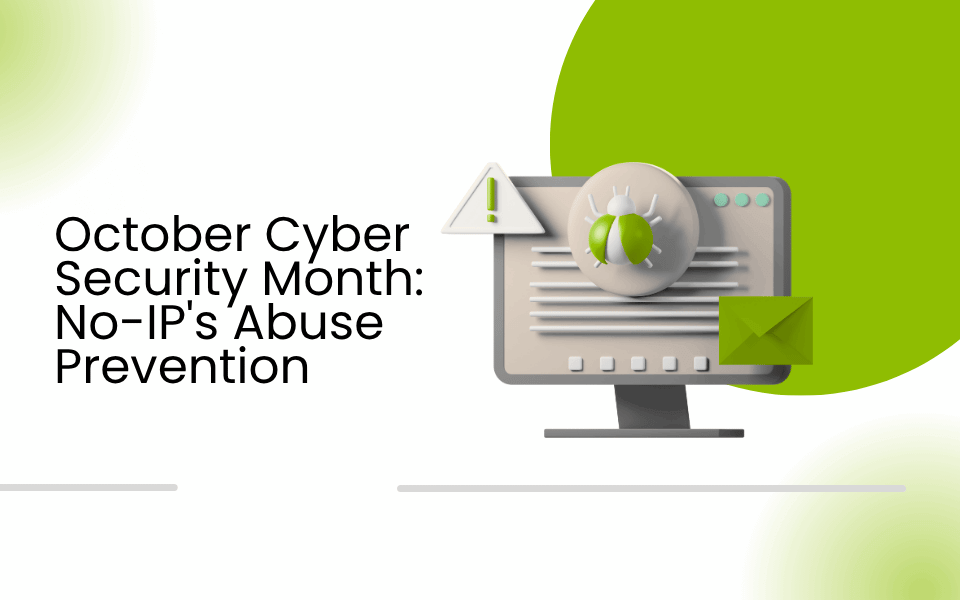
The No-IP Abuse Prevention Team: Proactive vs. Reactive
Did you know that October is Cyber Security Month? Cyber Security Month was started by The National Cybersecurity Alliance and Cybersecurity and Infrastructure Security Agency (CISA) as an effort to provide resources and information for companies and users to practice online safety.
This year’s theme for Cyber Security Month is “Stay Safe Online”, which highlights the simple ways that people, home users and businesses alike, can ensure that they protect themselves from online dangers. These small actions include using strong passwords, updating software, and turning on multifactor authentication. At No-IP, we believe that routinely practicing responsible protocols is a great and simple way to navigate technology safely. however, we also believe in keeping our users safe by providing reliabile uptime and proactively preventing bad actors.
No-IP’s Mission to Keep Users Safe
There comes a point where users can only do so much to keep themselves or their businesses safe online. Luckily, No-IP has implemented a layered strategy to prevent domain and hostname abuse and to proactively identify and reduce malicious activity. The No-IP’s Abuse Prevention team works together multiple times a day, every day, to ensure that any abusive accounts are flagged and dealt with. The team has measures in place that include processes for ongoing improvement and internal protocols used to prevent repeated offenses.
Their standard process goes as follows:
1. Measures to Prevent Incidents
- Internal Database Scanning: No-IP regularly scans internal databases for known malicious redirect targets. These targets are continuously updated as new threats are identified.
- Malicious IP Blocking: The team maintains an internal blacklist of known malicious IP addresses. Any identified IPs are blocked from use across our systems, and the list is updated on an ongoing basis.
- IP Association Monitoring: No-IP scans for newly identified IP addresses that are linked to multiple user accounts, which often signals coordinated attacks.
2. Content Monitoring
- Detection Tools: No-IP is continuously testing and improving internal tools to detect abuse patterns.
- Historical Data Analysis: Using historical data, No-IP is able to identify recurring patterns and determine potential risks.
- Domain Validation: New domain registrations require validation procedures to reduce the risk of misuse.
- Expanded Investigations: When an external report is received, the team not only investigates the specific hostname or domain in question, but also searches for related domains, hostnames, IP addresses, targets, and accounts that may be involved in coordinated abuse.
3. Internal Protocols and Proactive Processes
- Ongoing Process Evaluation: No-IP’s internal policies are routinely reviewed and updated to adapt to evolving threats and to remain compliant with best practices.
- Cross-Team Collaboration and Partners: No-IP contracts with several reputable companies that provide near real-time threat intelligence. When one of our domains is reported by users or identified by other means, the team receives detailed information and takes action immediately. A dedicated team handles abuse reports, and they work closely to share findings with other departments who help design and build tools and features to mitigate abuse.
- Rapid Response Procedures: Upon detection or report of a violation, No-IP takes immediate action to disable the offending hostname or domain and prevent further abuse.
4. Commitment to Continuous Improvement
- Combating malicious activity is a top priority for No-IP. We are committed to continually evaluating and improving our systems to stay ahead of emerging threats. Our goal is to proactively identify and address issues before they escalate or require external intervention.
Continuous Dedication to Our Users
The No-IP team takes abuse prevention seriously to continue our integrity, but also to uphold our users’ trust in our services. Want to learn more about what else No-IP has to offer? Check us out here.